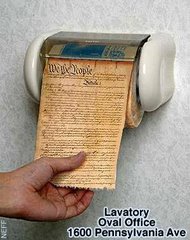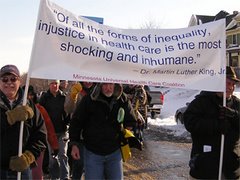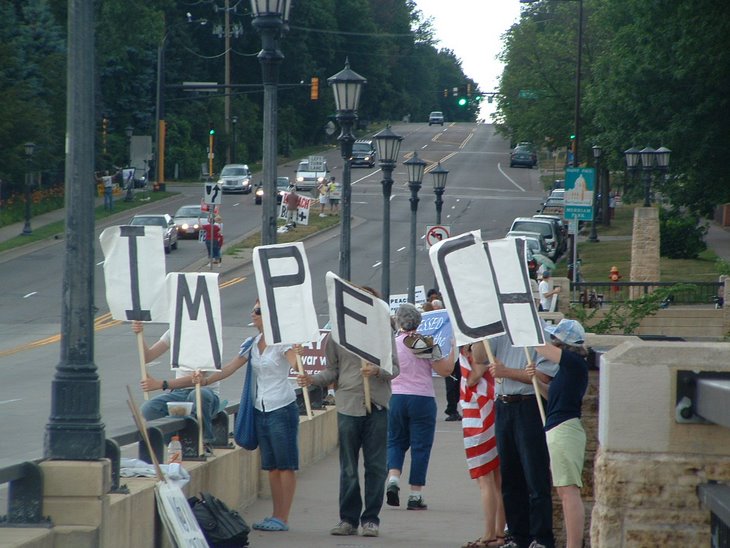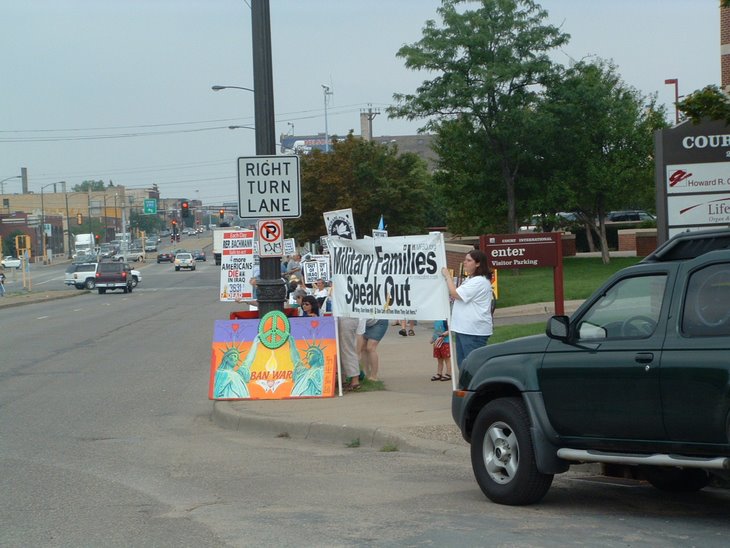Sunday, October 4, 2009
Health care: The facts begin to trickle in
Health insurance bills could be hardship for many
By RICARDO ALONSO-ZALDIVAR, Associated Press Writer Ricardo Alonso-zaldivar, Associated Press Writer – Sun Oct 4, 2009
Link: http://news.yahoo.com/s/ap/20091004/ap_on_go_co/us_health_care_affordability
WASHINGTON – Many middle-class Americans would still struggle to pay for health insurance despite efforts by President Barack Obama and Democrats to make coverage more affordable.
The legislation advancing in Congress would require all Americans to get insurance — through an employer, a government program or by buying it themselves. But new tax credits to help with premiums won't go far enough for everyone. Some middle-class families purchasing their own coverage through new insurance exchanges could find it out of reach.
Lawmakers recognize the problem.
"For some people it's going to be a heavy lift," said Sen. Tom Carper, D-Del. "We're doing our best to make sure it's not an impossible lift."
Added Sen. Olympia Snowe, R-Maine: "We have no certainty as to whether or not these plans are going to be affordable." Both are on the Senate Finance Committee, which finished writing a health care bill on Friday.
A new online tool from the Kaiser Family Foundation illustrates the predicament.
The Health Reform Subsidy Calculator provides ballpark estimates of what households of varying incomes and ages would pay under the different Democratic health care bills. The legislation is still a work in progress and the calculator only a rough guide. Nonetheless, the results are revealing.
A family of four headed by a 45-year-old making $63,000 a year is in the middle of the middle class. But that family would pay $7,110 to buy its own health insurance under the plan from the committee chairman, Sen. Max Baucus, D-Mont.
The family would get a tax credit of $3,970 to help pay for a policy worth $11,080. But the balance due — $7,110 — is real money. Maybe it's less than the rent, but it's probably more than a car loan payment.
Kaiser's calculator doesn't take into account co-payments and deductibles that could add hundreds of dollars, even several thousand, to a family's total medical expenses. A Congressional Budget Office analysis estimates total expenses could average 20 percent of income for some families by 2016.
The issue of affordability "has been lurking in the background and is nowhere near resolved yet," said Kaiser's president, Drew Altman. "It's tricky because it doesn't take a lot of people to make affordability a political problem. It just takes some very visible and understandable cases."
At the root of the concerns is the push to cut the overall cost of health care overhaul legislation. Congress is trimming the budget for subsidies to meet Obama's target of $900 billion over 10 years — as the Baucus plan does. It means premiums will be higher than under earlier Democratic proposals.
The trade-off directly affects people who buy their own coverage. For those with job-based insurance, employers would continue to cover most of the costs.
Most of the uninsured are in households headed by someone who's self-employed or works at a business that doesn't provide coverage. It's this group that Democrats are trying to help.
Because health insurance is so expensive, lawmakers recognize that if they're going to pass a law requiring all Americans to get coverage, government has to defray the cost. The size of those subsidies makes an enormous difference.
Under the Baucus bill, a family of four making $63,000 would have to pay 11 percent of its income for health insurance, according to Kaiser. By comparison, an earlier bill from the Senate Health, Education, Labor and Pensions Committee with more generous subsidies required the same hypothetical family to pay about 7 percent of its income for premiums — a difference of about $2,500.
"This is not the loaves and the fishes — you can't just throw some subsidies out there and expect that will take care of everybody's needs," said Karen Pollitz, a Georgetown University professor who studies the insurance market for people buying their own coverage.
The legislation provides the most generous subsidies to those at or near the poverty line, about $22,000 for a family of four. That's where the problem is concentrated because about three-fourths of the uninsured are in households making less than twice the poverty level.
But as income rises, the subsidies taper off.
For a family of four making $45,000, federal subsidies would pick up 71 percent of the premium under the Baucus plan, according to the Kaiser calculator.
For a family with an income of $63,000, the subsidies would only cover 36 percent of the premium.
A family making $90,000 would get no help.
Pollitz said the subsidies disappear rapidly for households with solid middle-class incomes. That could be tricky for a self-employed individual who has a particularly good year financially.
Another problem is that people won't be able to get the insurance tax credits immediately after the bill passes. To hold down costs, the assistance won't come until 2013, after the next presidential election.
White House officials say that while Obama wants the cost of the final bill to stay manageable, it has to provide affordable coverage.
"The president is absolutely committed to making this affordable. That's the whole point," said Linda Douglass, spokeswoman for the White House health reform office.
Douglass said it's premature to draw any conclusions while the bill is being shaped in Congress. But House leaders are also cutting back their legislation to meet Obama's target.
Acknowledging the affordability problem, Baucus' committee voted Friday to exempt millions of people from the requirement to buy insurance and reduce penalties for those who fail to do so. But that would mean leaving at least 2 million more uninsured — not very satisfying to Democrats who started out with the goal of coverage for all.
"I think we've got to do something about it," said Sen. Chuck Schumer, D-N.Y. "We've got to make sure health insurance is affordable for the middle class."
By RICARDO ALONSO-ZALDIVAR, Associated Press Writer Ricardo Alonso-zaldivar, Associated Press Writer – Sun Oct 4, 2009
Link: http://news.yahoo.com/s/ap/20091004/ap_on_go_co/us_health_care_affordability
WASHINGTON – Many middle-class Americans would still struggle to pay for health insurance despite efforts by President Barack Obama and Democrats to make coverage more affordable.
The legislation advancing in Congress would require all Americans to get insurance — through an employer, a government program or by buying it themselves. But new tax credits to help with premiums won't go far enough for everyone. Some middle-class families purchasing their own coverage through new insurance exchanges could find it out of reach.
Lawmakers recognize the problem.
"For some people it's going to be a heavy lift," said Sen. Tom Carper, D-Del. "We're doing our best to make sure it's not an impossible lift."
Added Sen. Olympia Snowe, R-Maine: "We have no certainty as to whether or not these plans are going to be affordable." Both are on the Senate Finance Committee, which finished writing a health care bill on Friday.
A new online tool from the Kaiser Family Foundation illustrates the predicament.
The Health Reform Subsidy Calculator provides ballpark estimates of what households of varying incomes and ages would pay under the different Democratic health care bills. The legislation is still a work in progress and the calculator only a rough guide. Nonetheless, the results are revealing.
A family of four headed by a 45-year-old making $63,000 a year is in the middle of the middle class. But that family would pay $7,110 to buy its own health insurance under the plan from the committee chairman, Sen. Max Baucus, D-Mont.
The family would get a tax credit of $3,970 to help pay for a policy worth $11,080. But the balance due — $7,110 — is real money. Maybe it's less than the rent, but it's probably more than a car loan payment.
Kaiser's calculator doesn't take into account co-payments and deductibles that could add hundreds of dollars, even several thousand, to a family's total medical expenses. A Congressional Budget Office analysis estimates total expenses could average 20 percent of income for some families by 2016.
The issue of affordability "has been lurking in the background and is nowhere near resolved yet," said Kaiser's president, Drew Altman. "It's tricky because it doesn't take a lot of people to make affordability a political problem. It just takes some very visible and understandable cases."
At the root of the concerns is the push to cut the overall cost of health care overhaul legislation. Congress is trimming the budget for subsidies to meet Obama's target of $900 billion over 10 years — as the Baucus plan does. It means premiums will be higher than under earlier Democratic proposals.
The trade-off directly affects people who buy their own coverage. For those with job-based insurance, employers would continue to cover most of the costs.
Most of the uninsured are in households headed by someone who's self-employed or works at a business that doesn't provide coverage. It's this group that Democrats are trying to help.
Because health insurance is so expensive, lawmakers recognize that if they're going to pass a law requiring all Americans to get coverage, government has to defray the cost. The size of those subsidies makes an enormous difference.
Under the Baucus bill, a family of four making $63,000 would have to pay 11 percent of its income for health insurance, according to Kaiser. By comparison, an earlier bill from the Senate Health, Education, Labor and Pensions Committee with more generous subsidies required the same hypothetical family to pay about 7 percent of its income for premiums — a difference of about $2,500.
"This is not the loaves and the fishes — you can't just throw some subsidies out there and expect that will take care of everybody's needs," said Karen Pollitz, a Georgetown University professor who studies the insurance market for people buying their own coverage.
The legislation provides the most generous subsidies to those at or near the poverty line, about $22,000 for a family of four. That's where the problem is concentrated because about three-fourths of the uninsured are in households making less than twice the poverty level.
But as income rises, the subsidies taper off.
For a family of four making $45,000, federal subsidies would pick up 71 percent of the premium under the Baucus plan, according to the Kaiser calculator.
For a family with an income of $63,000, the subsidies would only cover 36 percent of the premium.
A family making $90,000 would get no help.
Pollitz said the subsidies disappear rapidly for households with solid middle-class incomes. That could be tricky for a self-employed individual who has a particularly good year financially.
Another problem is that people won't be able to get the insurance tax credits immediately after the bill passes. To hold down costs, the assistance won't come until 2013, after the next presidential election.
White House officials say that while Obama wants the cost of the final bill to stay manageable, it has to provide affordable coverage.
"The president is absolutely committed to making this affordable. That's the whole point," said Linda Douglass, spokeswoman for the White House health reform office.
Douglass said it's premature to draw any conclusions while the bill is being shaped in Congress. But House leaders are also cutting back their legislation to meet Obama's target.
Acknowledging the affordability problem, Baucus' committee voted Friday to exempt millions of people from the requirement to buy insurance and reduce penalties for those who fail to do so. But that would mean leaving at least 2 million more uninsured — not very satisfying to Democrats who started out with the goal of coverage for all.
"I think we've got to do something about it," said Sen. Chuck Schumer, D-N.Y. "We've got to make sure health insurance is affordable for the middle class."
Subscribe to:
Comments (Atom)











































































































